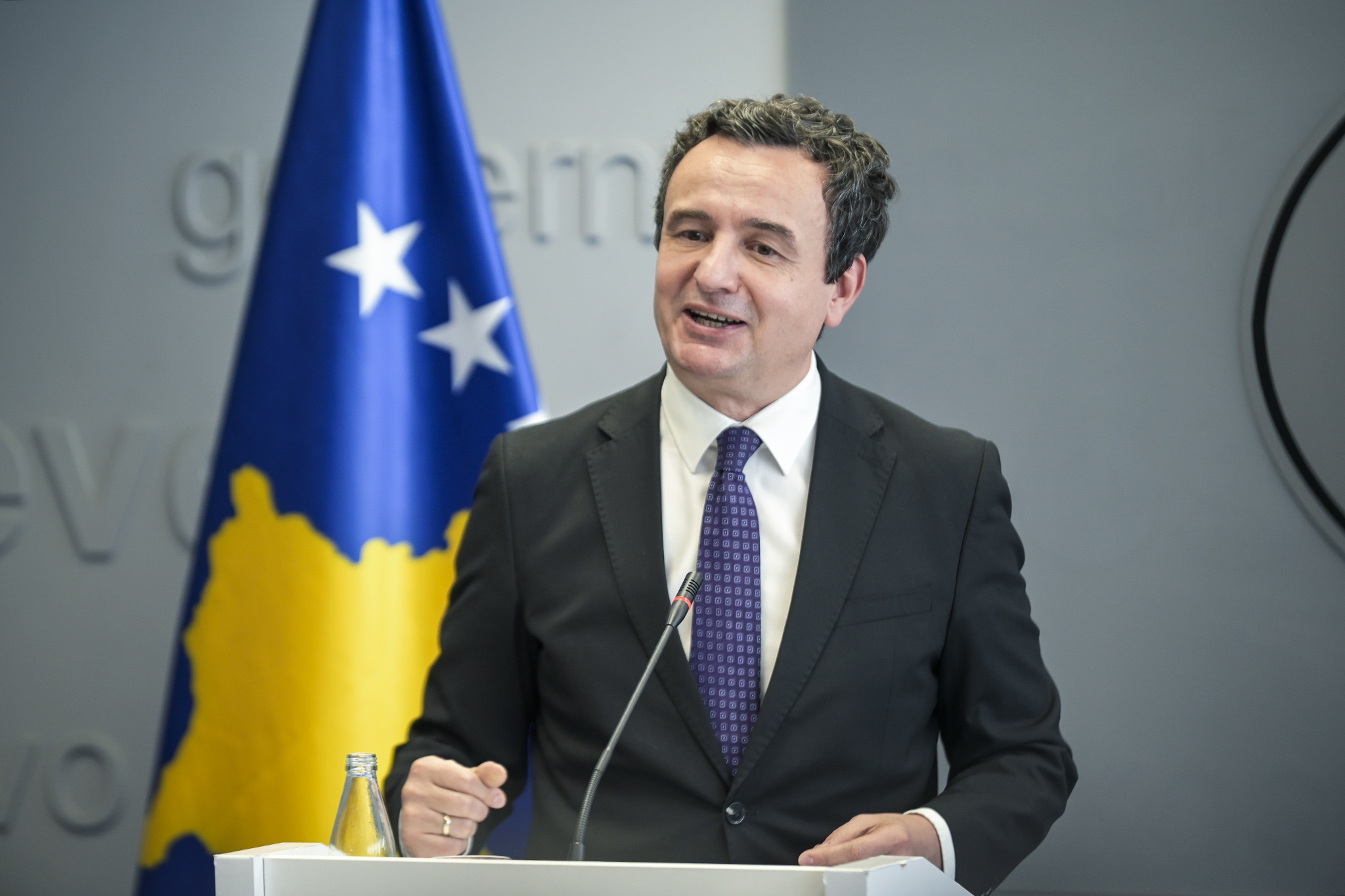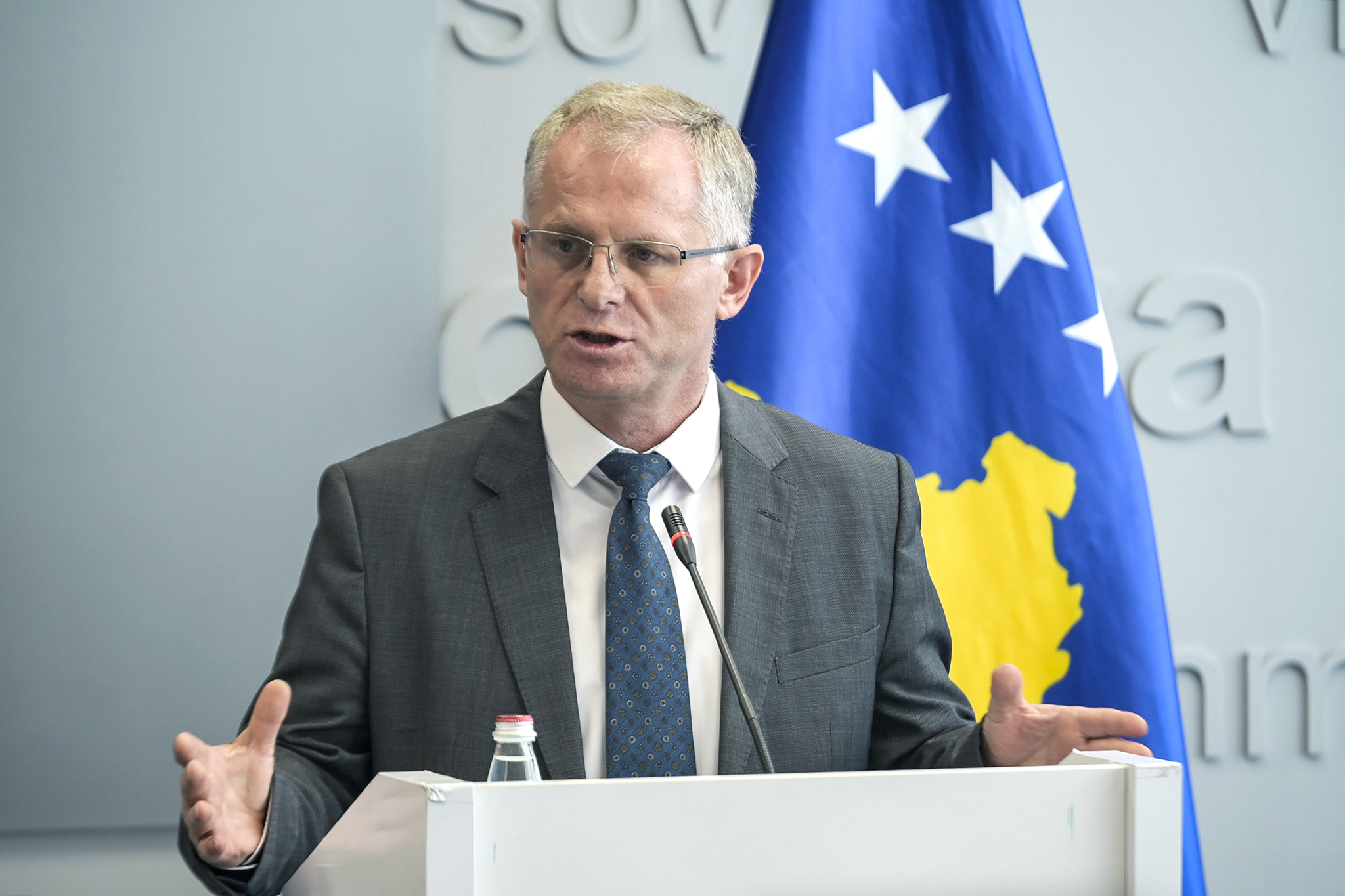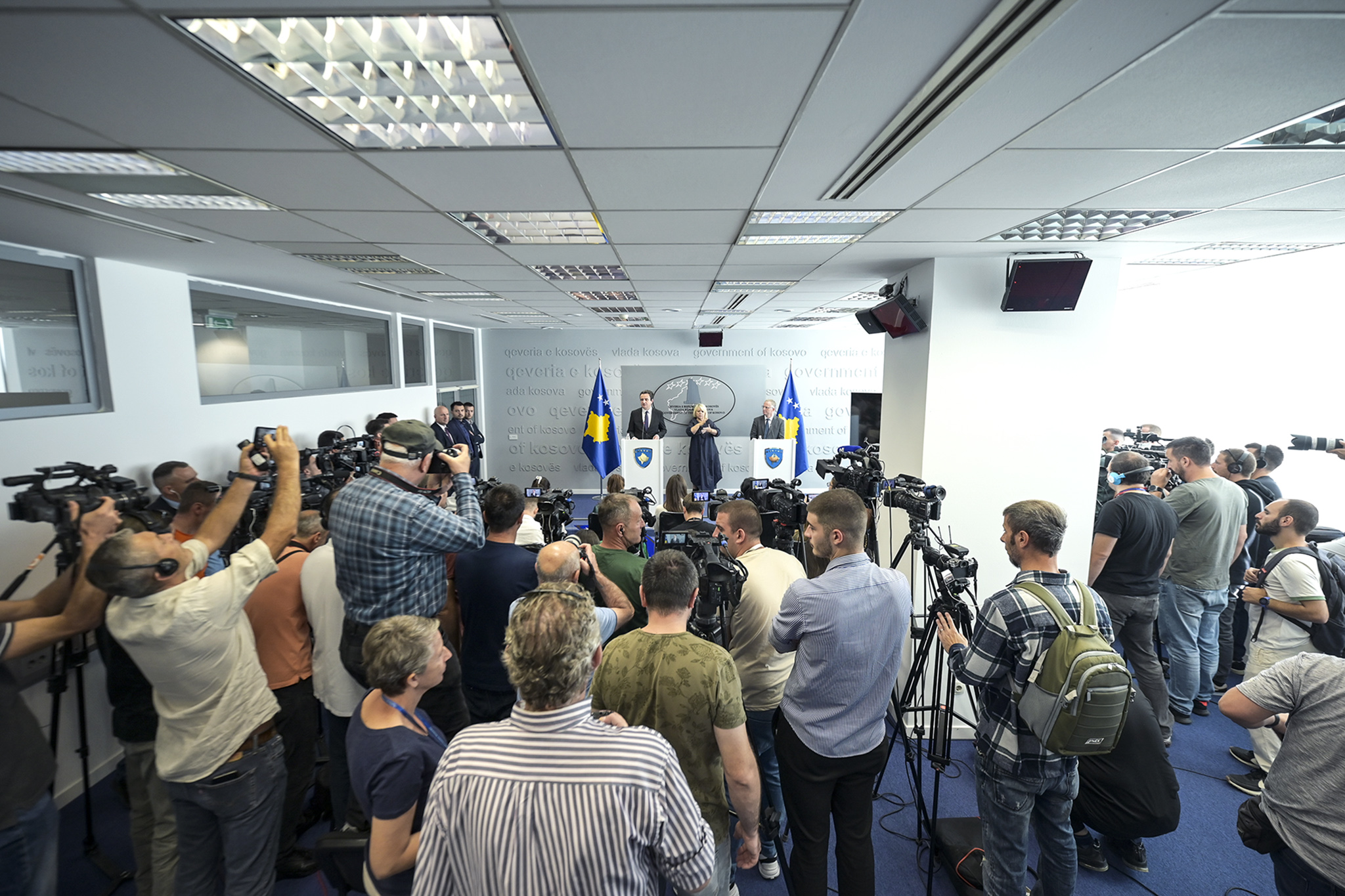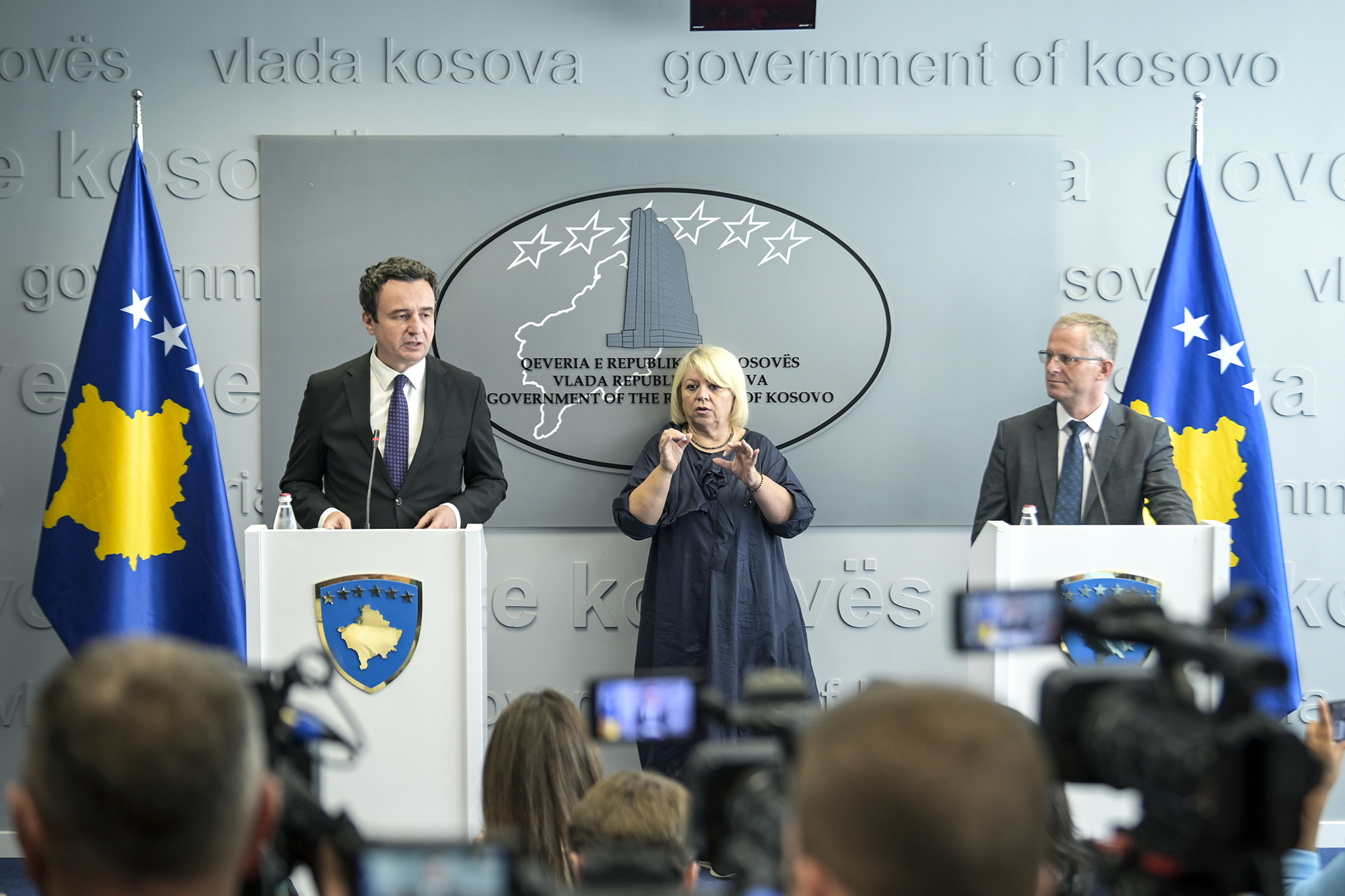Prishtina, 18 September, 2023
Dear representatives of the media,
Dear citizens,
I am here today to inform you about the last high-level meeting within the framework of the Brussels dialogue, organized on September 14, that is, Thursday of the week we left behind.
The invitation to the meeting of the High Representative did not define any specific item on the agenda, however it was stated that the purpose of the meeting is to discuss the implementation plan of the Basic Agreement between Kosovo and Serbia.
I went to the meeting with a concrete proposal, in my opinion very constructive, in which we envisaged a full implementation of the Basic Agreement. Our proposal was based on the principle of inclusiveness, which meant that every defining article of the Basic Agreement and its implementing Annex had to necessarily be included in the sequenced implementation plan. The principle of inclusiveness is not something I discovered, nor is it unusual in the implementation plans of international agreements. Inclusion, namely the obligation to implement each article of the Basic Agreement is defined by the Implementation Annex itself, approved in Ohrid on March 18. There, in that Annex, it is determined in three specific clauses that each article, I repeat, that each article of the Basic Agreement must be implemented and also that the parties cannot express obstructions to any article.
This is more than usual, logical and hundreds of years of practice in the implementation of international agreements.
In the first bilateral meeting I had with the High Representative Josep Borrell and the Facilitator Miroslav Lajcak, I was asked to move immediately to a negotiation process of the statute defined in Article 7 of the Basic Agreement in conjunction with Article 10. I did it is clear that they could not take such a step without fully agreeing on the Sequential Implementation Plan, all the more because the President of Serbia, Aleksandar Vučić, has been declaring up and down that he “does not have accepted an agreement” with Kosovo, and that it “will implement it only in accordance with Serbia’s red lines”. Taking a cue from this context, I made it clear to the two European representatives that the first step should be to agree on a sequencing plan and, in it, foresee the signing of the Basic Agreement or at least its deposit by Representative Borrell in the Office of the Secretary General of the United Nations Organization, the organization that mandated the facilitating function of the European Union for the Dialogue between Kosovo and Serbia.
In the first meeting, we did not reach a minimal understanding, since the position of Mr. Borrell and Mr. Lajçak was that the sequencing of the implementation of the agreement should be done in such a way that it would be acceptable to Serbia as well, which wanted the Association as a priority and removal of de facto mutual recognition articles.
From there I made it clear to them that the sequencing of the implementation of the Basic Agreement did not require a new negotiation: it had to be a natural result, technically a reflection, of each article of the Basic Agreement. Such a thing is natural since we accepted the Basic Agreement and its Annex; otherwise, it would mean giving up an important part of the Basic Agreement.
In the second meeting, the trilateral one with the participation of the President of Serbia, I was exposed to a scenario which Mr. Lajcak seemed to have designed it long ago.
After I proposed to the President of Serbia and the two European representatives a sequencing plan worked out by the Republic of Kosovo, which is actually the first document that I propose in a high-level meeting, even though the chief negotiator, Deputy Prime Minister Besnik Bislimi has proposed in the past four months, two more sequencing plans were rejected by Mr. Lajcak, the President of Serbia and Miroslav Lajcak reacted with the same opinion and with the same coordinated disregard. The second said that this plan is very unrealistic and therefore the only way forward is the non-sequenced implementation of the point of negotiation of the charter of an association of municipalities. There I posed the question, which point, according to them, of this sequencing proposal, is not provided for in the Basic Agreement?! I received no response, because of one simple fact: every point of my sequencing plan proposed there was explicitly derived from the letter of each article of the Basic Agreement. I had not invented or added anything. Everything that was written in my proposal was approved by all of us on March 18 of this year at the meeting that resulted in the agreement in Ohrid. After being rejected by Vucic and Lajcak, I asked them both a basic question: I said, if you are rejecting my proposal, then tell me if Serbia has ever proposed a sequencing plan? Mr. Lajcak said yes, with full conviction, Serbia [he said] has brought its proposal as well. I insisted on seeing that document. We had my proposal in front of us, Serbia’s proposal we did not know.
I was not given that document, and after much insistence after the end of the last bilateral meeting, I was brought a document that I was told is Serbia’s proposal for the sequencing plan.
The meeting ended there. Vuçiqi went to a press conference and warned what happened an hour later, he said that Kurti will be criticized for rejecting the proposals of the mediator Lajçak. I heard Vucic’s warning verbatim at High Representative Borrell’s press conference.
After analyzing the document that Lajcak told me was Serbia’s proposal for the sequencing plan, I realized from the content of that document, which you all have now, that such a claim by Lajcak was at best untrue. That document seemed to have been submitted at the time of the negotiations before Ohrid, even before the adoption of the Basic Agreement, and Serbia had never brought any proposal for the sequencing of the Basic Agreement.
The failure to bring such a proposal, the mediator Lajçak had hidden to such an extent that he amnestied the rejecting attitude towards the Agreement, about which Vucic spoke every week after March 18. You also have in mind his conference, dated April 24, when he said that he accepts the Agreement only in concept, not in content, and that he considers its implementation to be limited, that is, incomplete.
So I understood that that document of Serbia, which in the title showed the intention to ignore the Basic Agreement – “First the implementation of the Association and then the discussion on the Plan Proposed by the European Union” -, had in fact been transformed into the attitude of the Facilitator or Lajçak mediators. As such, Lajcak and Vuçiqi seem to have been coordinated with a single goal: to make possible the impossible scenario in which the Agreement is implemented, and to give life to an alternative scenario where only half of the Agreement apply and the other half, what constitutes the most civilized part of good neighborly, democratic and European relations, non-representation of each other in international relations, etc., should never be applied.
My rejection of such a scenario is an initially logical action, then an indicator of political responsibility towards the Republic that I represent and also an indicator of respect for the values of the European Union, which are embodied precisely in articles 1 to 5 of the Basic Agreement that Lajçak and Vuqiçi want to make them disappear from the implementation plan. To say that an agreement deserves to be implemented only half of it is the same as saying that the agreement should be scuttled.
Therefore, I did not accept such a scenario, because for me and for the European Council, such an agreement exists and cannot be undone by anyone.
After the meetings ended and after my media appearance in Brussels where I exposed this nonsensical scenario in which the aim is to kill the entire Basic Agreement except for the association, the mediator released to the media a sequencing document which said that “Vuciqi accepted and Kurti refused it”. Such information is completely untrue, added here that Lajcak’s plan implements exactly what Serbia was looking for in its document that I mentioned earlier.
How can a document be presented at the meeting on September 14 when in the same document it was written that its date is July 19 of this year, the date when there was a meeting of chief negotiators Bislimi and Petkovic in Brussels?! Such a document of Lajcak was rejected on the date it marked, that is, July 19, so it was immediately rejected by the chief negotiator, Deputy Prime Minister Bislimi at the Brussels meeting of the first two months. Why all this information crap from Lajcak’s office? I believe that everyone understands this, because it is clear that the information from Lajcak’s office is such that they did not worry about his neutrality and to protect the comprehensiveness of the sequenced implementation plan, and we paradoxically ended up in a situation where Vucic’s warnings match with what the mediator then says.
Allow me to finish my introductory speech with the conclusion that on September 14, there was a clear positioning of the mediator against Kosovo in general and against the Basic Agreement in particular. Thus, they have gone too far with the blow to the future of Kosovo. In the situation we are in, I appreciate that I cannot be swayed in my judgment by any favoritism. Either we will implement the Basic Agreement in its entirety, or we cannot implement only what Serbia wants. This logic is dead and an Independent Republic of Kosovo cannot, should not and will not walk on such a path.
Thank you.
Last modified: September 19, 2023




